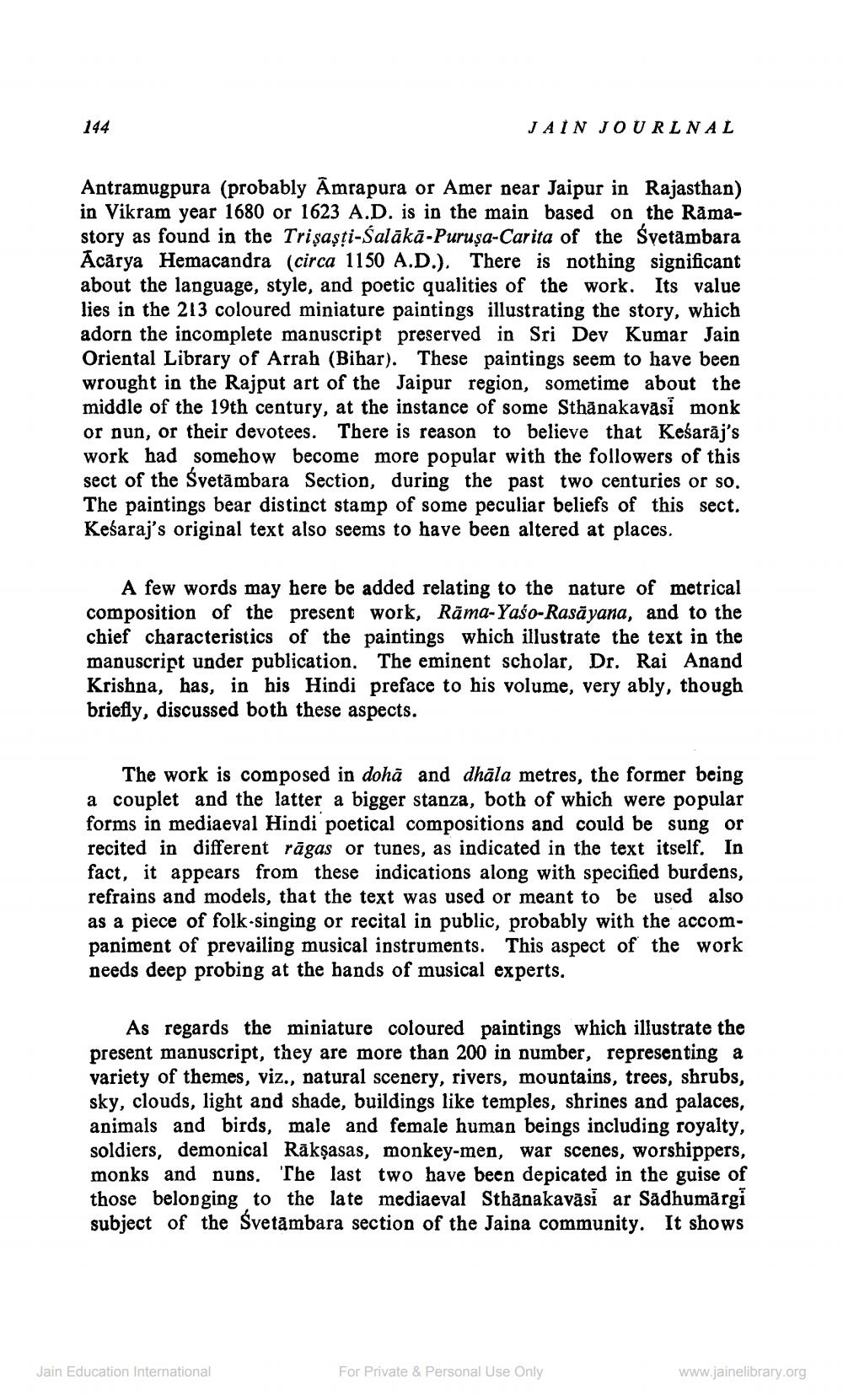Book Title: Jain Journal 1991 10 Author(s): Jain Bhawan Publication Publisher: Jain Bhawan Publication View full book textPage 8
________________ JAIN JOURLNAL Antramugpura (probably Amrapura or Amer near Jaipur in Rajasthan) in Vikram year 1680 or 1623 A.D. is in the main based on the Ramastory as found in the Trişaşti-Salākā-Purusa-Carita of the Svetambara Acārya Hemacandra (circa 1150 A.D.). There is nothing significant about the language, style, and poetic qualities of the work. Its value lies in the 213 coloured miniature paintings illustrating the story, which adorn the incomplete manuscript preserved in Sri Dev Kumar Jain Oriental Library of Arrah (Bihar). These paintings seem to have been wrought in the Rajput art of the Jaipur region, sometime about the middle of the 19th century, at the instance of some Sthănakavasi monk or nun, or their devotees. There is reason to believe that Kesarăj's work had somehow become more popular with the followers of this sect of the Svetāmbara Section, during the past two centuries or so. The paintings bear distinct stamp of some peculiar beliefs of this sect. Keśaraj's original text also seems to have been altered at places. A few words may here be added relating to the nature of metrical composition of the present work, Rāma-Yaśo-Rasāyana, and to the chief characteristics of the paintings which illustrate the text in the manuscript under publication. The eminent scholar, Dr. Rai Anand Krishna, has, in his Hindi preface to his volume, very ably, though briefly, discussed both these aspects. The work is composed in dohã and dhāla metres, the former being a couplet and the latter a bigger stanza, both of which were popular forms in mediaeval Hindi poetical compositions and could be sung or recited in different rāgas or tunes, as indicated in the text itself. In fact, it appears from these indications along with specified burdens, refrains and models, that the text was used or meant to be used as a piece of folk singing or recital in public, probably with the accompaniment of prevailing musical instruments. This aspect of the work needs deep probing at the hands of musical experts, As regards the miniature coloured paintings which illustrate the present manuscript, they are more than 200 in number, representing a variety of themes, viz., natural scenery, rivers, mountains, trees, shrubs, sky, clouds, light and shade, buildings like temples, shrines and palaces, animals and birds, male and female human beings including royalty, soldiers, demonical Rākşasas, monkey-men, war scenes, worshippers, monks and nuns. The last two have been depicated in the guise of those belonging to the late mediaeval Sthanakavāsi ar Sadhumärgi subject of the Svetămbara section of the Jaina community. It shows Jain Education International For Private & Personal Use Only www.jainelibrary.orgPage Navigation
1 ... 6 7 8 9 10 11 12 13 14 15 16 17 18 19 20 21 22 23 24 25 26 27 28 29 30 31 32 33 34 35 36 37 38 39 40 41 42 43 44 45 46 47 48 49 50 51 52 53 54 55 56 57 58
